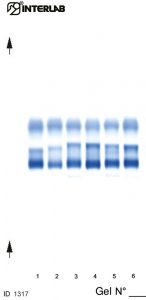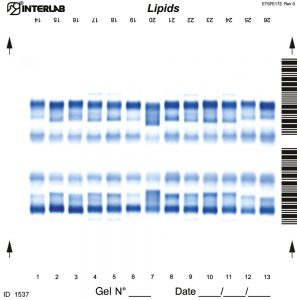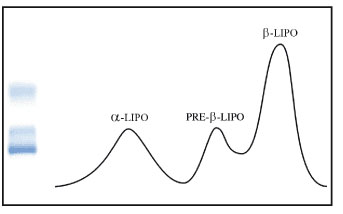


| REF | DESCRIPTION | SAMPLES PER GEL | TEST PER KIT |
|
|
|---|---|---|---|---|---|
| SRE648K | LIPOPROTEINS ELECTROPHORESIS KIT | 6 | 60 | ||
| SRE606K | 13 | 130 | |||
| SRE621K | 26 | 260 |
The Lipoproteins Electrophoresis kits are intended for the separation of lipoproteins in human serum by electrophoresis on agarose gel plates. Visual inspection of the pattern is performed to detect abnormalities, including variations of the bands or appearance of extra bands. Densitometry of the pattern allows the relative quantification of lipoprotein zones. The kits have been designed for use with the fully automated instruments Easy Interlab G26 & Pretty Interlab.

Reagent Preparation:
All reagents ready to use except Stain Solution to be reconstituted as shown in the procedure
Sample Preparation:
Fresh neat serum samples
Sample Storage & Stability:
Serum: 2 days at 2 to 8°C
Lipids display a number of different and important roles in metabolic processes, they serve as hormones, they participate in digestion, act as an energy store, can be used as metabolic fuel and are important components of biological membranes.
Correlation between plasma lipid abnormalities and atherosclerosis have been established.
Lipoproteins are macromolecular complexes composed of lipids and proteins.
Lipoproteins are spherical particles consisting of a core of non polar lipids surrounded by polar lipids and one or more proteins, the apoproteins, at the surface. The core contains triglycerides, cholesterol esters, phospholipids and free cholesterol. The different proportions in the lipoprotein complexes of proteins and lipids allow their separation by electrophoresis on agarose gel, based on differences in their net charge.
At alkaline pH four bands can be resolved: alpha-lipoprotein, pre-beta-lipoprotein, beta-lipoprotein and chylomicrons.
Disorders of lipoproteins metabolism comprise a variety of conditions including hyperlipoproteinimias due to increased production of lipoproteins. They have been classified according to Fredrickson and co-workers into five main groups, each associated to an electrophoretic pattern and graph. Interpretation of these profiles is important for the management of hyperlipoproteinemias.
Interfering substances:
EDTA activates lipases and should be avoided.
